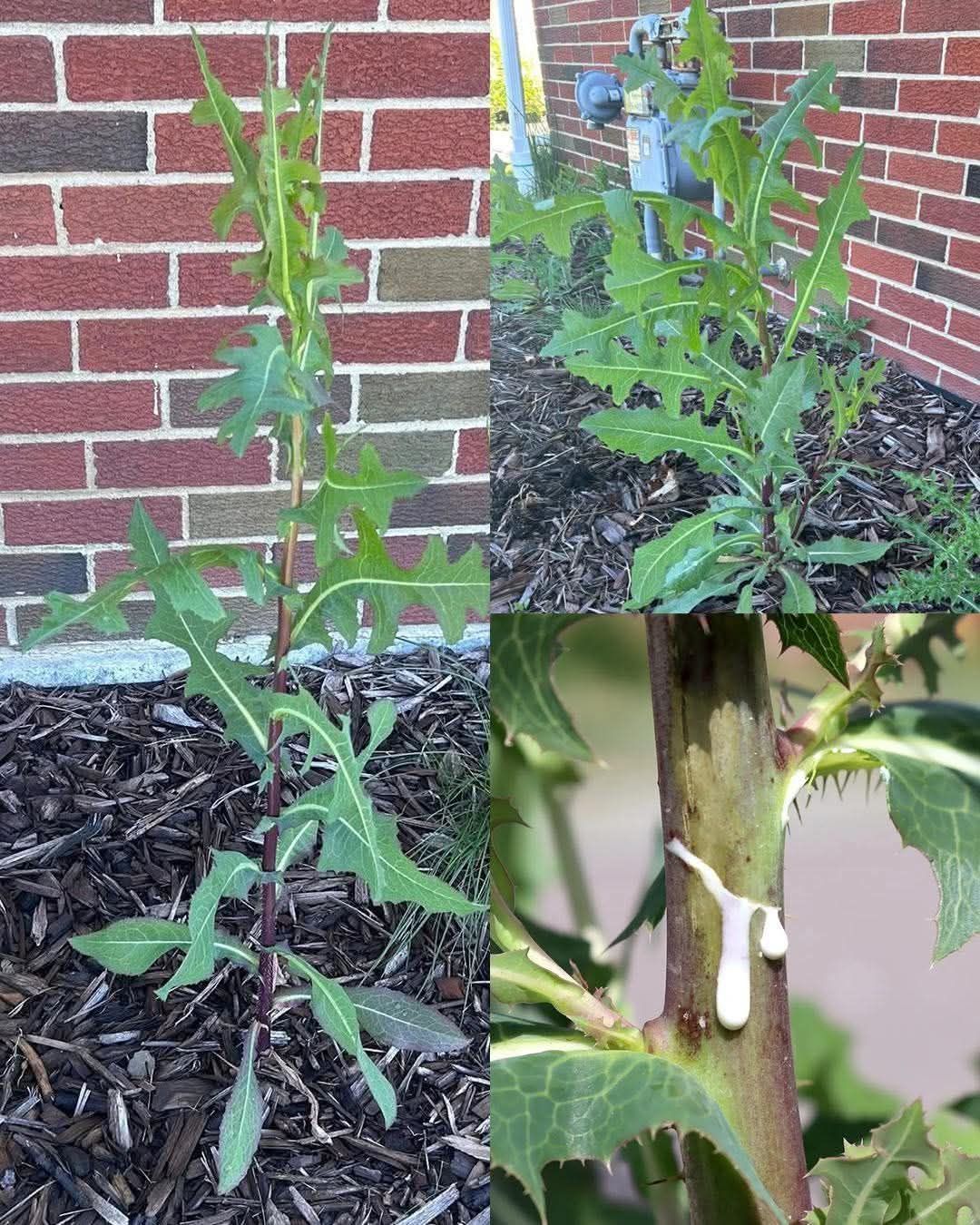Tall Stems: Can grow quite tall, often 3-6 feet.
Leaves: Often deeply lobed or toothed, with a distinct row of prickly spines on the underside of the central vein of the leaf (L. serriola). Leaves may turn to face the sun.
Flowers: Small, pale yellow, resembling dandelions, appearing in summer (June-August).
Milky Sap: When any part of the plant is cut or broken, it exudes a white, milky latex (the lactucarium).
Where to Find It: Wild lettuce commonly grows in disturbed areas like roadsides, fields, forest edges, and abandoned lots. Ensure you harvest from areas free from pesticides or pollutants.
2. How to Collect Wild Lettuce Sap (Lactucarium)
Directly collecting pure, dried sap (lactucarium) can be time-consuming and inefficient. Many experienced foragers and herbalists recommend processing the whole plant to extract its beneficial compounds, as the active constituents are present throughout the plant material, not just the isolated sap.
Traditional (and less efficient) Sap Collection:
Make small incisions on the stem or leaves.
Allow the milky sap to well up and dry on the plant.
Scrape off the dried, brownish, tar-like substance (lactucarium). This method yields very small amounts.
More Efficient Extraction Methods (for broader use):
Most sources suggest making tinctures or decoctions from the whole plant material (leaves and stems), as this captures a wider range of active compounds more effectively.
Harvesting: The best time to harvest for medicinal purposes is typically when the plant is “bolting” (sending up its flower stalk) but before the flowers fully open. At this stage, the sap is believed to be most concentrated. Harvest on a dry day.
Preparation for Extraction:
Cut the stems and leaves into smaller pieces (e.g., ½-1 cm for stems, leaf pieces the size of a small coin). This increases surface area for extraction.
Alcohol Tincture (Common Method):
Blend fresh wild lettuce leaves and stems with high-proof alcohol (e.g., 190 proof or high-grade vodka). The active compounds (lactucin and lactucopicrin) are soluble in alcohol.
Use a ratio of plant material to alcohol (e.g., 1:2 or 1:3 by weight).
Let the mixture steep in a dark, cool place for several weeks (2-6 weeks).
Strain the plant material through a cloth filter, pressing out all liquid.
Store the tincture in a dark bottle in a cool, dry place.
Water Decoction:
For tougher plant material, decoction is used. Place chopped wild lettuce (leaves and stems) in a pot, cover with water (e.g., twice the volume of plant material).
Bring to a boil for 5 minutes, then simmer until the water reduces by about 75% (leaving 25% of the original volume).
The resulting liquid will be very bitter and can be further reduced to a thicker, tar-like consistency, or kept more liquid.
Store in the fridge or reduce to a dry goo/tar in a dehydrator for longer storage.
3. How to Use Wild Lettuce (and its Sap/Extracts)
The primary traditional uses revolve around its sedative and analgesic (pain-relieving) properties.
Tincture/Extract: This is the most common way to use wild lettuce for its internal effects. Dosing can vary greatly, and it’s crucial to start with very small amounts and assess your reaction.
Often taken sublingually (under the tongue) for faster absorption, or mixed in a small amount of water.
Tea: Made from dried leaves and flowers. While less potent than tinctures, it can be used for mild calming effects or to aid sleep.
Topical Application: The latex (sap) has historically been applied directly to the skin to potentially kill germs or relieve irritation, though this can also cause skin irritation.
4. Potential Benefits of Wild Lettuce Sap/Extracts
Pain Relief: Traditionally used for headaches, muscle pains, joint aches, and general discomfort. Animal studies suggest pain-relieving effects comparable to ibuprofen at certain doses, but human studies are lacking.
Sedation and Sleep Aid: Known for its calming effects on the nervous system, it has been used to promote relaxation and aid sleep, particularly for insomnia and restlessness.
Anxiety Reduction: May help calm the mind and reduce nervousness or anxiety.
Respiratory Health: Historically used for coughs (especially dry, spasmodic coughs) and asthma due to expectorant and anti-inflammatory properties.
Anti-inflammatory Effects: Some compounds may help reduce inflammation, which could benefit conditions like arthritis.
Diuretic and Laxative: Traditional uses include addressing fluid retention and promoting bowel movements.
Other Traditional Uses (less scientific evidence): Whooping cough, urinary tract problems, painful menstrual periods, poor circulation, and as a blood purifier.
5. Important Precautions and Side Effects
Wild lettuce is not without risks, and scientific evidence for its benefits is limited.
Dosage is Crucial: Large amounts can be dangerous, potentially causing slowed breathing, excessive sleepiness, dizziness, sweating, dilated pupils, vision changes, ringing in the ears, and even death.
Side Effects: Can cause skin irritation when applied topically. Internal use may lead to drowsiness, dizziness, and other central nervous system effects.
Interactions:
Sedatives: Can increase sleepiness when taken with other sedative medications (e.g., clonazepam, lorazepam, zolpidem).
Surgery: Stop using wild lettuce at least 2 weeks before any scheduled surgery due to its effects on the central nervous system and potential interaction with anesthesia.
Contraindications:
Pregnancy and Breastfeeding: Avoid use due to insufficient safety data.
Enlarged Prostate (BPH): May worsen this condition.
Narrow-angle Glaucoma: Contains a chemical that might exacerbate this eye condition.
Allergies: People allergic to ragweed, chrysanthemums, marigolds, daisies, or other members of the Asteraceae/Compositae family may have an allergic reaction.
Identification Errors: Misidentifying wild lettuce and consuming a toxic plant can lead to severe health consequences.
Lack of Regulation: Herbal supplements are not as strictly regulated as pharmaceuticals, so quality and potency can vary widely.
Always prioritize safety. If you are considering using wild lettuce, especially for medicinal purposes, speak with a qualified healthcare professional or experienced herbalist. They can provide personalized advice and discuss safer, evidence-based alternatives for your specific needs.
ADVERTISEMENT

